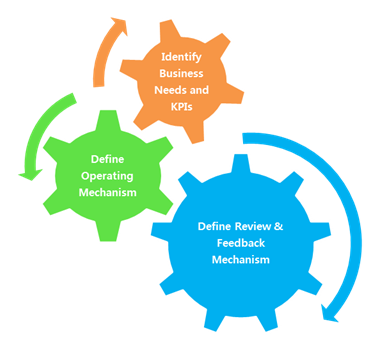Operating Rhythm can be defined as a set of pre-defined process of communication and interactions that should be present between different departments to ensure that the flow of operations is not interrupted and is controlled as intended. It provides a structured way of communication through which the stakeholders communicate to the project team/operations and vice versa on items like roles, milestones, outcomes, targets and so on that is aligned to the organization’s vision.
Each organization has a vision based on which the Business Strategy Plans are prepared. These Plans have to be communicated and reviewed at a defined frequency to ensure that the Plans are being achieved without any bottlenecks. For this an organization has to identify the applicable KPIs linked with the Plans. Once the KPIs are defined, these have to be communicated to all the stakeholders and a review plan defined at regular intervals.
The reviews and interviews should be defined such that all the relevant points are discussed and any bottlenecks cleared giving a beneficial stand to these reviews and meetings. A strong emphasis should be laid on communicating the right information which is crucial in proper Operating Rhythm followed by review meetings which should be effective and efficient.
Why is Operating Rhythm needed?
Why can’t normal communication plan be enough?
Remember, Operating Rhythm is not a separate process or method. It is a state that the organization’s management and communication team should attain in order to ensure smooth, seamless operations enabled by timely and effective communication. While a normal communication plan targets only passing of information without any clear KPIs or reviews and can therefore not good enough to achieve the Planned Business Strategy of an Organization.
Be it a manufacturing industry or a service sector, the role of communication is very crucial in not only in management of its day-to-day operations but also for strategy planning. In today’s scenario, where company’s operations and teams are spread across the globe, Operating Rhythm is a must for every organization that wants to achieve operational excellence, increase process efficiency and reduce cost and time.
Gone are the days when the company had one Operations team and other support teams. Today each team has a business process, and every team is treated like it runs its own operation that adds value to the entire organizational objective. Adding to the changes, are the outsourcing and off-shoring business models, where a part of the operations are performed by vendors and partners operating from different parts of the globe, in different time zones and with different organizational objectives.
In such a scenario, achieving organizational effectiveness, product/process compliance, increase efficiency of operations is very critical. Operating Rhythm is a guideline that helps you in achieving all of the above in a simple and effective manner.
How can Operating Rhythm be achieved?
To achieve Operating Rhythm one needs to ensure the below:
- Identify Business Needs / KPIs
- Identify the stakeholders and their needs.
- Map the needs of the business and process to specific KPIs defined by the organization.
- Plan who, how and when the KPIs should be captured and recorded?
- Define Operating Mechanism
- Define the tasks to be performed
- Define the ownership and process of collecting data
- Define how and through what mode the communication will be shared with the stakeholders.
- Define Review and Feedback Mechanism
- Define the review items, frequency for Meetings
- Define the Process of CAPA and decision making on the basis of performance of metrics.
- Identify the owners for action items and time line for process correction.
The above points and picture gives a broad idea on what needs to be done to achieve Operating Rhythm.
How does Operating Rhythm help an Organization?
The below are the results of achieving Operating Rhythm:
- In the process of achieving Operating Rhythm, an organization devises a Predefined communication plan that simplifies the job of Execution team. It ensures that all necessary information are communicated, tracked in a timely and orderly fashion. This helps to stream line the information flow within and outside the organization.
- Also, a Clear ownership on tasks that should be performed by each individual and the process to be followed for it are established. This reduces confusions among employees on who needs to deliver what, when and how.
- A well planned Metric collection and monitoring system is devised which reduces the complexity of collecting ad-hoc data and analysis process. Also, it eliminates the variation in the approach for metric calculations. It standardizes the entire KPI measurement process.
- It reduces time and effort spent on unnecessary meetings and Review items. The core purpose of Meetings and Reviews are to assess the performance of KPIs and set mid-term corrective actions and to issue directions on Change management activities (if any). By streamlining the review process and objectives, the time and effort spent by management and other key personnel are saved, which can be used for other useful processes and activities.
- Operating Rhythm ensures timely and Proper Information flow across the organization which creates and optimizes Value flow. Timely and accurate Information is Value in any business.
- By streamlining the Communication flow and ownership of tasks, it eliminates follow-ups and Reminders for all the process, which is a major bottleneck in any organization.
Thus, Operating Rhythm amidst other management methodologies and initiatives is a major requirement for success of any business regardless of the nature and size of an organization.

